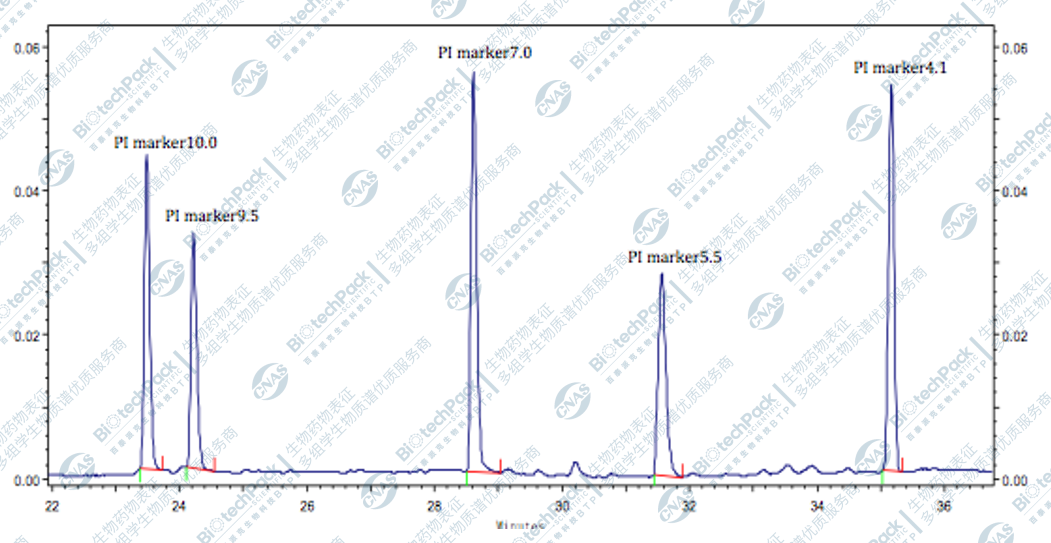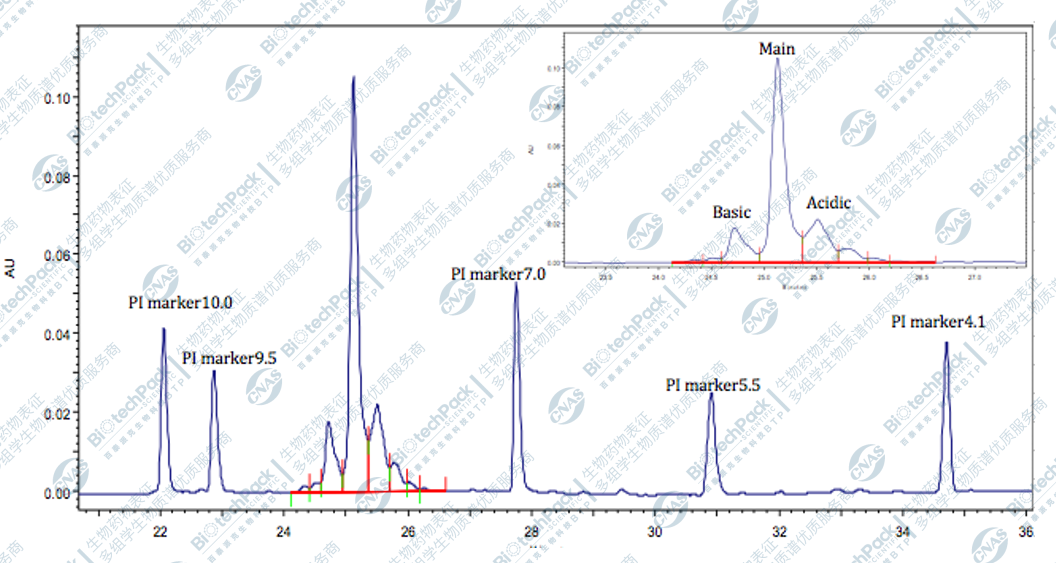Protein Isoelectric Point Analysis Based on cIEF
The isoelectric point of proteins is closely related to their amino acid sequence and three-dimensional structure. The isoelectric point of a specific protein is fixed, so by comparing the isoelectric points of different proteins, we can study the structural and functional differences between them. Accurate determination of the isoelectric point is an important step in characterizing the charge heterogeneity of biological products.
Protein isoelectric point analysis based on the principle of capillary isoelectric focusing (cIEF) is the most commonly used method in detecting the isoelectric point of biological products. This micro-separation technique operates by applying a direct current voltage across the ends of a capillary, forming a pH gradient with carrier ampholytes inside the capillary. Proteins move towards the anode or cathode depending on their charge until they reach a pH value where their net charge is zero (i.e., the isoelectric point pI), at which point they stop moving and focus into very narrow bands, thereby achieving separation and obtaining the isoelectric point information of the protein.
Protein isoelectric point detection based on cIEF offers short analysis time, high resolution, good reproducibility, high accuracy, and low sample consumption. It has become one of the key technologies in the development and quality control of various biological products such as amino acids, peptides, recombinant proteins, antibodies, and vaccines.
Biotech company BTP has been certified under both CNAS and ISO9001 quality systems. Referring to the 2020 edition of the Chinese Pharmacopoeia, Part III General Rule 0542/Part IV General Rule 0542 Capillary Electrophoresis, the company established a protein isoelectric point detection platform based on the cIEF principle for different categories of biological products. This platform allows for precise measurement of isoelectric points for proteins, antibodies, vaccines, peptides, and recombinant collagen, and can provide a comprehensive service including method development, validation, and subsequent sample testing. BTP also offers otherCharacterization of biological productsrelated services, click to learn more.
Laboratory Equipment
- BECKMAN COULTER PA800+ Capillary Electrophoresis System
TechnologyApplication
cIEF offers advantages such as short analysis time, high resolution, good reproducibility, high accuracy, and low sample consumption. This method has become one of the key technologies in the development and quality control of various biological products such as amino acids, peptides, recombinant proteins, antibodies, and vaccines.
Case Illustration
During the experiment, samples are mixed with ampholytes and five standard pI markers, and detected using a capillary electrophoresis system. The samples undergo electrophoretic focusing in the capillary, and the isoelectric point of the test sample is calculated based on the retention time of the five internal standards.

Figure 1: pI Marker Results

Figure 2: Monoclonal Antibody Sample Detection Results
CommonQ&A
Question 1: Why are the isoelectric points of most proteins neutral to slightly acidic?
Answer: Proteins are composed of amino acids, and most amino acids have isoelectric points lower than the pH of the human body (pH=7.4). Therefore, the isoelectric points of most proteins are slightly acidic, such as the isoelectric point of goat pepsin which is approximately 3.
Question 2: Are there proteins with basic isoelectric points?
Answer:Yes, there are proteins with basic isoelectric points. When a protein contains a higher proportion of basic amino acids, such as histidine, arginine, and lysine, its isoelectric point can be basic, such as with protamine which has an isoelectric point of around 12.
Question 3: How to choose between two methods for isoelectric point detection?
Answer:Isoelectric point detection using cIEF requires samples to have UV absorption at 280nm; for samples without UV absorption at 280nm (e.g., collagen), isoelectric point detection based on IEF should be used.
One-stop service for protein isoelectric point analysis based on cIEF
You only need to place an order and send the samples
BTP one-stop service completes: sample processing, instrument analysis, data analysis, and project report
Related Services
How to order?





